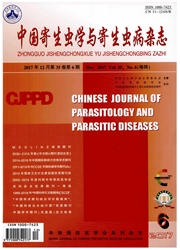

 中文摘要:
中文摘要:
目的 筛选雌性日本血吸虫特异表达基因。方法 感染日本血吸虫6周的家兔,用静脉灌注法收集成虫,经核糖核酸固定液固定,分别提取雌、雄成虫总RNA,纯化后获得mRNA,并反转录为cDNA。用抑制性消减杂交技术(SSH)构建雌、雄成虫正向消减(雌虫消减雄虫)及反向消减(雄虫消减雌虫)cDNA文库。用斑点杂交法筛选差异表达基因,挑选目标基因片段(与正向消减探针杂交的信号明显高于与反向消减探针杂交信号的克隆)进行测序、同源性搜索及基因功能预测分析。以日本血吸虫肌动蛋白(actin)基因作内参照,用半定量PCR(semiquantitative PCR)鉴定目标基因在雌、雄虫体内的表达。结果 得到正向消减及反向消减cDNA文库,斑点杂交筛选出50个雌虫特异性表达的克隆,经测序得到42个表达序列标签(EST),其中,有17个基因(占40.5%)与已知日本血吸虫卵壳蛋白基因高度同源;17个基因(占40.5%)与日本血吸虫未知基因高度同源、且有一小片段与卵壳蛋白基因高度同源;有8个基因(占19.0%)与日本血吸虫其他未知基因高度同源。半定量PCR结果,6个基因在雌虫体内的表达水平明显高于雄虫,分别与GenBank的血吸虫卵壳蛋白基因AY222885、AY222895、AB017097、AF519182、M32281及血吸虫其他基因AY813556高度同源。结论 构建了雌、雄成虫正向消减及反向消减cDNA文库。用SSH可筛选日本血吸虫雌性特异性表达基因。
 英文摘要:
英文摘要:
Objective To screen the Schistosoma japonicum female specific expressing genes. Methods S. japonicum adult worms were collected from the rabbits' vein after six-week infection by affusing method. The adult worms were stabilized by RNA-later liquid, the male and female worms were carefully separated with nipper. The high quality total RNA was extracted and mRNA was obtained after purification. Double stranded cDNAs were synthesized after reverse transcription. Female subtractive (female as tester, male as driver) and male subtractive (male as tester, female as driver) cDNA libraries were constructed. The differentially expressed genes were further screened by dot-blot hybridization. The clones were selected and sequenced, which showed apparendy higher signals when hybridizing with the female subtracting male probes, than those signals when hybridizing with the male subtracting female probes. The homology of these sequences was searched with BLAST program. The semiquantitative PCR was applied to test the differential gene expression in female and male adult worms. Result Female subtracting male and male subtracting female cDNA libraries were constructed with SSH technique. After dot-blot hybridization, 50 clones were tested to be the potential female differentially expressed genes and were sequenced. 42 expressing sequence tags (ESTs) were received. After bioinformatics analysis, 17 fragments ( about 40. 5% ) showed high identity with the S. japonicum egg-shell protein genes, 17 sequences( about 40. 5%) were highly homologous to unknown S. japoniucm genes and partly homologous to female specific 800 protein. 8 fragments ( about 19.0% ) showed high identity with other S. japonicum unknown genes. The fragments in clones of 577, 579, 668, 695, 720, and 708 were tested by RT-PCR to be the differentially expressed genes in female adult worms using S. japonicum actin gene as the internal standard. These fragments were highly homologous to S. japonicum egg shell protein gene AY222885, AY222895, A
 同期刊论文项目
同期刊论文项目
 同项目期刊论文
同项目期刊论文
 期刊信息
期刊信息
